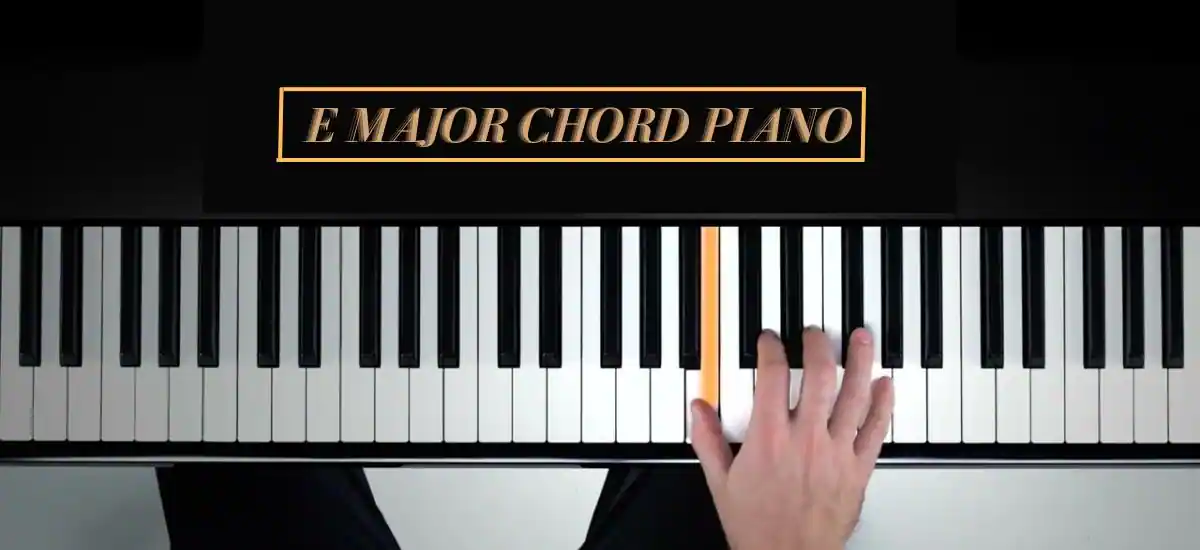E, G, and a perfect fifth constitute the E major chord (B). If you’ve followed the previous lessons on C, F, and G major chords, you should now be familiar with playing an E major chord. When finding a chord, we always place our right thumb on the root note.
In this article, we’ll delve into the E Major to help you become proficient at playing the E major chord on the piano. Like other tonal chords, it begins with its root note, E, and forms a triad.
How To Play E Major Chord on Piano
Follow these steps to play the E major chord on the piano:

- Place your thumb on E, your middle finger on G sharp, and your little finger on B on the piano keyboard.
- For a full sound, play all three notes simultaneously.
To play the E major chord in its first inversion, position your thumb on G#, your index finger on B, and your fifth finger on E, pressing all the notes simultaneously.
Initially, let’s try working intuitively. Our fifth finger will likely strike the B note if we stick to the plan of playing E-G-B with the 1,3,5 fingers. That’s how we discovered the prior chord.
These are the notes that, strung together, form an E major chord.

Pressing the E, G#, and B notes will produce a perfect sound, resulting in a minor third due to the interval created by the distance between G# and B—a chord in the key of E major.
Notes in an E Chord
E, G-sharp, and B are the notes that make up the E major triad, often simply referred to as the E major chord or the E chord for short.

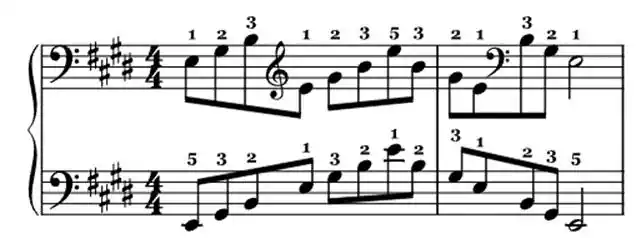
It is said that a chord is arpeggiated when the notes that make up the chord are played sequentially. You must familiarize yourself with these fingerings!
If the note E, which is the root of the E chord, is the bass note (also known as the bottom note), then the chord is in the root position:


The chord is considered to be in the first inversion when the bottom note is the chord’s third, which is G# sharp:
The chord is in the second inversion when the bass note is the chord’s fifth, B (Note B is referred to as the chord’s fifth because the interval that stretches from the root note E to B is a fifth).
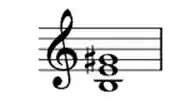
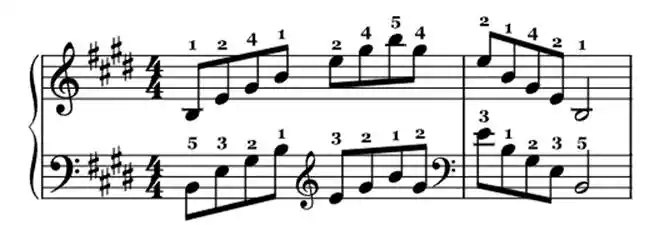
E Chord Piano Finger Position
First, let’s look at the E major chord played in the root position. Put your thumb on E, middle finger on G sharp, and little finger on B on the piano keyboard. For a full sound, play all three notes simultaneously.
To play the E major chord in its first inversion, position your thumb on the G# string, your index finger on the B string, and your fifth finger on the E string, pressing the notes simultaneously.
When playing the E chord in its second inversion, slide your thumb up to the B position, and place your middle finger on E and your little finger on G#. Press these notes simultaneously.
The following keys naturally include the E major chord in their tonal structure:
- E major (chord I) / C# minor (chord III)
- A major (chord V) / F# minor (chord VII)
- B major (chord IV) / G# minor (chord VI)
There is no dissonance between E major and Fb major (F flat major). The term “enharmonic” refers to chords that have the same sound but are written differently. Despite being written with different notations, they produce the same pitch. Both E major and Fb can be formed by playing identical keys on the piano.
E Chord Piano Inversions
Root Position
To begin playing an E major chord in the root position, locate the note E at the bottom of the scale. The group of two black keys to the right of the E key indicates that it is the fourth group. This chord may be played using the following fingers in its root position:
- B – Fifth finger (5)
- G♯ – Third finger (3)
- E – First finger (1)
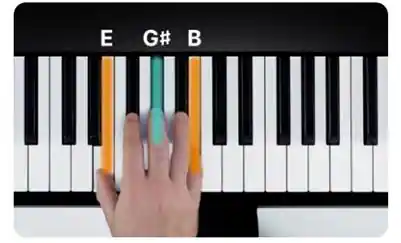

To play the chord in the root position with the left hand, use the following fingers:
- B – First finger (1)
- G♯ – Third finger (3)
- E – Fifth finger (5)
Some pieces of music may require you to use fingers differently than those typically used to play E major, which may change how you approach playing that key.
First Inversion
Positioning a G# below the other notes in an E major chord creates the first inversion. This chord is played using the following fingers on the right hand:


- E – Fifth finger (5)
- B – Second finger (2)
- G♯ – First finger (1)
Second Inversion
In the second inversion, B is the lowest note of the E major. To play the chord with your right hand, use the following fingers:


- G♯ – Fifth finger (5)
- E – Third finger (3)
- B – First finger (1)
Frequently Asked Questions
Q1. What is the E major chord on piano?
Ans. The E major chord on piano includes the notes E, G#, and B. It follows the scale formula of 1 + 3 + 5, with an intervallic pattern of a major third followed by a minor third.
Q2. How do you play an E major chord on piano?
Ans. To play the E major chord, position your first finger on B, your third finger on E, and your fifth finger on G#. For the left hand, place your fifth finger on B, your second finger on E, and your first finger on G#.
Q3. What notes make up the E major chord?
Ans. The notes E, G#, and B make up the E major chord. Remember, the formula for any major chord includes the 1st, 3rd, and 5th scale degrees, comprising a major third and a minor third interval.
Q4. What are the chords in the key of E major?
Ans. The triad chords in E major include E major, F# minor, G# minor, A major, B major, C# minor, and D# diminished. The four-note chords include E major, F# minor, G# minor, A major, B dominant, C# minor, and D# minor seventh flat five.
Final Thought:
Having a well-trained musical ear simplifies issues like these. Keep practicing until you master it. If you’re still having trouble, count the beats to ensure your ears aren’t deceiving you.
You May Also Like:
- How To Make a Sad Rap Piano Melody In FL
- What Does “Piano” Mean In Music Crossword?
- Best Tricks To Clean A Harmonica
Know More:- What Does Piano Mean In Music Crossword?

